When I was in college, I found my sexuality on Tumblr.
I’d never questioned my sexuality before – I’d dated guys on and off and I always felt romantic attraction to them – but being in the sex-filled culture of college simply confused me.
A friend would always tell me she was “sooo horny.” But when I asked her what being horny felt like, she couldn’t explain.
The idea of having sex just never came up in my mind. I always assumed I’d want to do it eventually, but here I was, in college, and I had no interest at all. It never occurred to me that that who I was attracted to romantically – who I wanted to cuddle and kiss – wasn’t necessarily who I was attracted to sexually.
Frankly, I thought I was doing pretty good in the relationship department, especially considering I’d been disabled from birth and disabled girls weren’t exactly first pick on the market.
At the time, I was on Tumblr, and it was there I found the notion of asexuality. Finally, I’d found people who didn’t care about sex!
I began identifying as asexual. (Now I identify as grey-asexual or sometimes demisexual; I usually say I’m “asexual spectrum.”) And one of the great things about the rise of the Internet is that marginalized groups have found spaces to gather with one another and discuss their experiences, like I did.
This is true with two often-misunderstood groups to which I belong – disabled people and asexual people.
Both communities often have their legitimacy questioned, and there are stereotypes about the sexuality (or lack thereof) of both communities. And as a multiply disabled asexual, I have faced backlash on all sides for my identity.
These two communities have a lot in common and should be working together. Yet I see each community trying to distance themselves from the other.
And while both sides are advocating for acceptance, they’re marginalizing the other even further.
It’s a type of horizontal oppression, and not only does it hurt both communities, but it also hurts people who straddle both worlds – disabled asexual people.
This ends up making disabled asexual people (like me) feel like they’re not wanted anywhere.
But if you become more aware of how you’re marginalizing disabled asexual folks, you can take the first steps towards welcoming us into your community.
So here are some examples of how you may be inadvertently doing this – and how to do better.
1. Empowering Disabled Sexuality While Ignoring Asexuality
I see this constantly, and while it’s not acceptable, it comes from centuries of desexualization of disabled people.
Disabled people have long been denied any sexual agency and were routinely sterilized in the early 20th century to prevent them from passing on their “defective” genes. Forced sterilizations still happen today under the guise of “treatment.”
So it’s not surprising that as disabled people have gained more civil rights, the taboo of disabled sexuality is being shattered.
Unfortunately, like the Hydra in Greek mythology (a snake monster with many heads, whose heads grow back multifold when one is decapitated), when oppression is invalidated, more crop up to take its place, particularly in the realm of media representation.
As people begin to realize that disabled people have sex, media has jumped on the bandwagon. An all-disabled orgy in Canada recently made headlines. Films like The Sessions and Margarita with a Straw have showcased the struggles disabled people face expressing their sexuality. The latter film even featured two disabled women of color having sex with each other!
It’s certainly a step in the right direction. Conversations are finally happening around disability and sexuality. In fact, a disability and sexuality conference is happening next month (I’ll be presenting on disability and asexuality!).
Because disabled people were denied any acknowledgment of their sexuality for so long, the cry has now become “Disabled people aren’t asexual! We want to have sex just like anyone else!”
Which is great.
But while both media coverage and activism surrounding disability and sexuality often reinforce the idea that disabled people want sex, have sex, and can be sexually desirable, this isn’t always true.
And as such, statements like these, while well-intentioned, deliver a double punch to disabled asexual people.
Firstly, they erase the existence of disabled asexual folks by presenting disabled people as a unified group who all share the desire for sex.
Secondly, they imply that there’s something wrong with those who aren’t “like everyone else” – the same thing that nondisabled people have been doing to disabled people for centuries.
So while disabled sexual empowerment is very much needed, it tends to throw asexual people “under the bus,” so to speak.
2. Framing Asexuality as a Mental Illness
As with other marginalized sexualities, asexuality is frequently treated as a mental illness that needs to be cured. (Fun fact: Homosexuality was a mental disorder included in the Diagnostic and Statistical Manual until 1973).
Asexuality has been pathologized as “Hypoactive Sexual Desire Disorder” and David Jay, founder of the Asexual Visibility and Education Network (AVEN) says there were many reports of asexuals being diagnosed with HSDD. Jay and others worked to get asexuality acknowledged as an exception to HSDD in the DSM-V a few years ago, and they won!
The DSM-V distinguishes between a generalized lack of sexual desire and a temporary lack – and even includes a note that some individuals may identify with asexuality rather than with the disorder.
Despite this progress, however, the fact that a lack of sexual desire is still classified as a psychiatric disorder says some revealing things about how society views marginalized sexualities, as well as general sexual (dys)function.
Sexual desire and fulfillment is still seen as cornerstones of a healthy relationship.
Michelle Duggar recently wrote that wives should “always be available” to meet their husband’s intimate needs. We are bombarded with media that lives by the motto “everything is better with sex.” One of the most enduring TV shows of the past several decades – Sex and the City, which I love – literally had “sex” in its title. And Viagra has become a cultural concept.
It’s no wonder that people who don’t conform to the constant messages of sex in our society are seen as having something “wrong” with them – and that’s exactly the problem.
The problem with framing asexuality as a mental illness is that invokes the medical model of disability – that something is “wrong” with you and that you need to be treated, fixed, and cured.
The crux of the disability rights movement rests on the social model of disability, which says that disability isn’t so much a result of biological deviance, but how society responds to that deviance.
For instance, the fact that I, as a wheelchair user, can’t get into some restaurants because they don’t have a ramp isn’t my fault for being disabled. It’s society’s fault for not having accessible buildings.
The implication of the “asexuality is a mental illness” concept is that “asexuals are sick, and they need to get better.”
This hurts mentally ill people of all orientations and identities by suggesting that mental illness is a bad thing.
Like all marginalized identities, mental illness is not inherently a bad or a good thing. It’s simply part of neurodiversity, the natural differences in human minds and brains. There is no one “normal” brain or mind – all ways of thinking and being are valid.
To treat asexuality as a mental illness that must be treated is reinforcing the concept that everyone should conform to one way of being.
The medicalization of asexuality is a problem, as it’s one of the ways asexuality is invalidated as an orientation. By placing asexuality squarely in the medical domain, it absolves people from having to think about it as a social issue.
However, the solution to this approach is not to shout, “Asexuality isn’t a mental illness!” (Sound familiar? Both groups treat the other like a sociological hot potato.)
3. Invalidating Asexuality as a Result of Existing Disability
This one crops up a lot in regards to autism and psychiatric disabilities.
If someone has a disability that can affect interactions with people, it’s treated as sort of a “get out of jail free” card.
“Your asexuality is a result of your disability!” people say. “That means it’s not a legitimate orientation!”
I fell into this trap myself for a long time.
Growing up with a physical disability left me somewhat sheltered. I didn’t have a lot of the social experiences that other kids did, because I physically couldn’t do the things they did. In high school, I was a loner, partially because a lot of social interaction outside of school involved being able to drive.
So when I started realizing that other people thought about sex, and I didn’t, I didn’t think too much of it. I thought I was just sheltered, and eventually my sexuality would blossom.
When I was first grappling with my asexuality, one of my fears was that I wasn’t “really” asexual because of those factors. I felt like I was appropriating the label from people who were just asexual, without a reason.
Eventually I came to the conclusion that my disability and my asexuality were two different things. But I shouldn’t have had to be forced into separating two parts of my identity.
Even discounting the fact that there are many asexuals who are not disabled, disability should not invalidate one’s orientation.
Autistic asexual blogger Alyssa says it best over at Yes, That Too:
Even if I were only asexual because of sensory issues – I’d still be asexual. Even if a person were only asexual because their hormones were a bit off what’s ‘expected,’ if they’re not experiencing sexual attraction and choosing to identify as asexual, they’re still asexual.”
Disability doesn’t preclude someone from having a sexual orientation.
I’ve realized that perhaps my disability does have something to do with my asexuality. After all, your past shapes who you are as a person. But even though I may be asexual because I’m disabled, that still doesn’t make my asexuality any less valid.
***
So if you find yourself marginalizing disabled asexual people, and you want to be more accepting, what can you do?
Here are two places to start.
1. Use ‘Some,’ ‘Many,’ and ‘Most’ Statements
Disabled people are a minority. And asexual people are a minority. No one is arguing those points.
There isn’t any concrete data on the amount of people with disabilities who are asexual, though logically, since disabled people are already a minority, disabled people are probably a minority within a minority in the asexual community.
In order to avoid inadvertently marginalizing disabled asexual people, your best bet is to use “some,” “many,” and “most” statements – because nothing is black and white, least of all sexuality.
Instead of saying “Disabled people aren’t asexual! We want sex,” try “Most disabled people aren’t asexual, but there are some disabled asexual people. Many disabled people want sex, and we can run the gamut of all sexual orientations, including asexuality.”
Instead of saying “Asexuality isn’t a disability! Asexual people aren’t disabled,” try “Asexuality isn’t a disability by itself, but there are disabled asexual people and their orientations are just as valid as nondisabled asexual people.”
Changing your language is one of the first and easiest steps to changing the environment.
2. Recognize That People Can Be Multiply Marginalized
Blogger elmindreda coined a term that I love, called “the difference slot.” It’s explained in this way:
The basic idea is that each and every person has their difference, and that it should be respected. Note the singular form, however. When they learn of my autism, which is usually the first major difference to come up in conversation, they seem to think ‘Oh, so that’s her difference.’ They then proceed to fill in my difference slot in their mental table, and everything is as it should be.
Or so they think.
Then, a little while later, I happen to mention some other thing that makes me very different from most other people, and their belief system collides head on with reality. Usually, it’s another one of my disabilities that triggers it. This is when they almost invariably go ‘…’ for a while, only to finish with “You have that, too?”
In other words, ‘Your difference slot is already filled, and you can’t have another one.’”
I experience the difference slot phenomenon a lot.
It’s one of the reasons I don’t talk about my asexuality much.
I believe this stems from the fact that those who take center stage in civil rights movements are generally the most privileged, because people will listen to those who have the most privilege.
Thus, multiply marginalized people are largely invisible and intersectionality is relegated to a social justice buzzword devoid of actual meaning.
In practical terms, this means that people usually only have a singly marginalized person in mind when they think about oppression.
But if you can make intersectionality a priority when talking about asexuality – or disability, or, of course, both – it’ll go a long way towards welcoming disabled asexual people into both movements.
This means committing towards accessibility in asexual spaces, and asexual acceptance in disability spaces.
And hopefully, the more that nondisabled asexual people and sexual disabled people make conscious efforts to accept and welcome disabled asexual people, the more it will become second nature.
Because we don’t deserve to be trampled on the way to empowerment.
[do_widget id=’text-101′]
Cara Liebowitz is a Contributing Writer for Everyday Feminism. She is a multiply-disabled activist and writer currently pursuing her M.A in Disability Studies at the CUNY School of Professional Studies in Manhattan. Her published work includes pieces in Empowering Leadership: A Systems Change Guide for Autistic College Students and Those with Other Disabilities, published by the Autistic Self Advocacy Network, and the Criptiques anthology. Cara blogs about disability issues large and small at That Crazy Crippled Chick. You can check her out on Twitter @spazgirl11.
Search our 3000+ articles!
Read our articles about:
Our online racial justice training
Used by hundreds of universities, non-profits, and businesses.
Click to learn more
Most Read Articles
- « Previous
- 1
- …
- 30
- 31
- 32





















